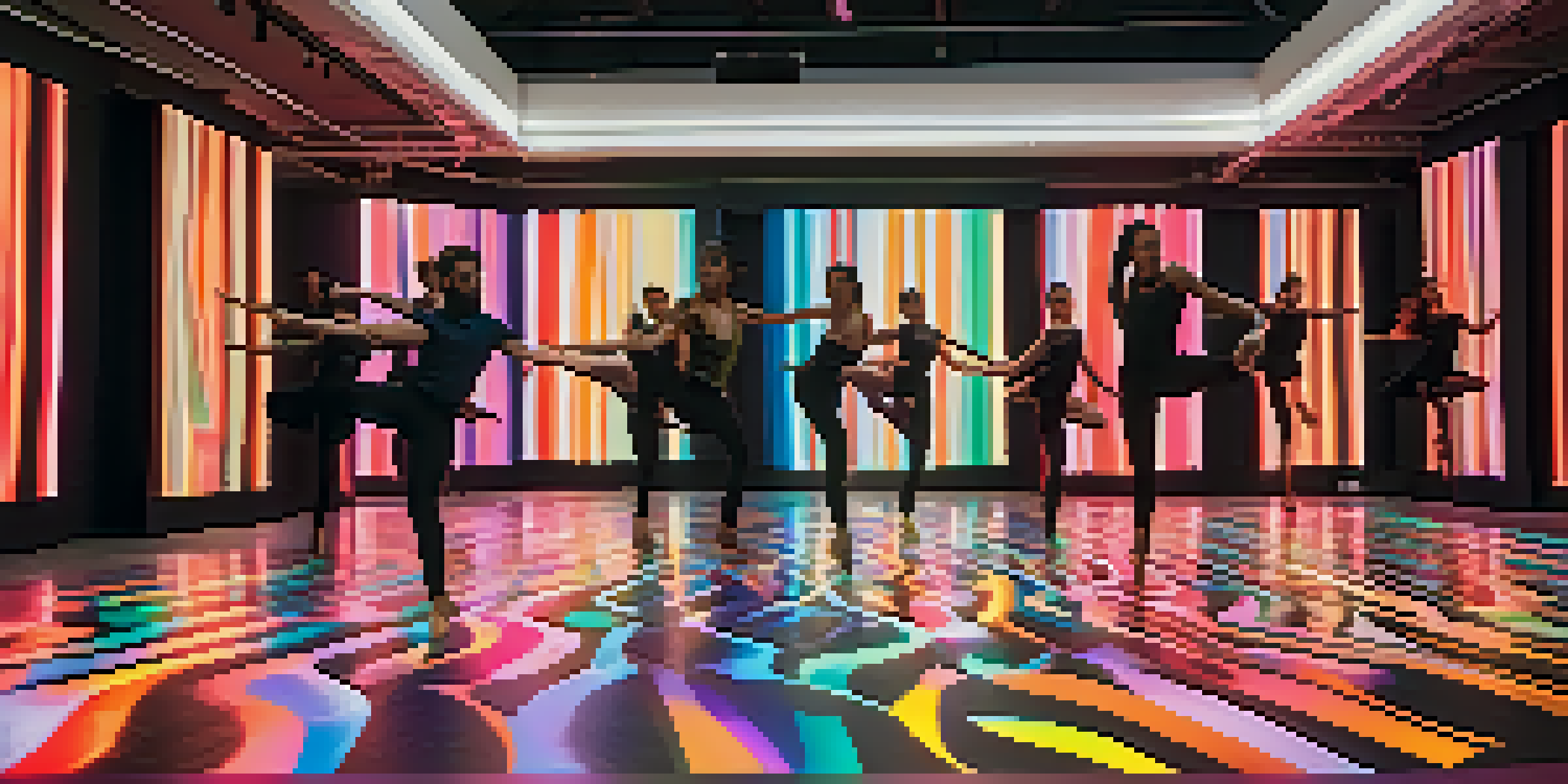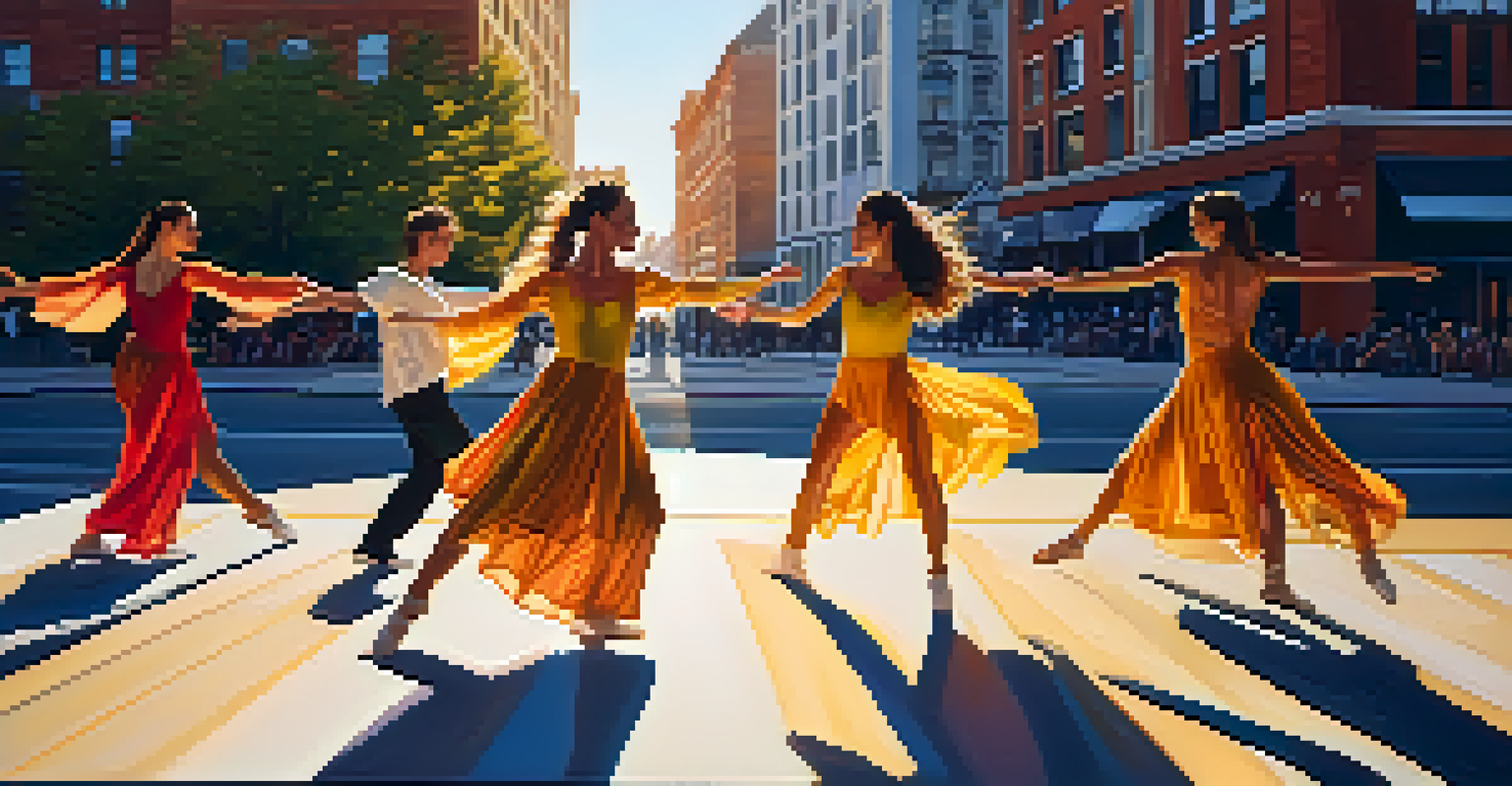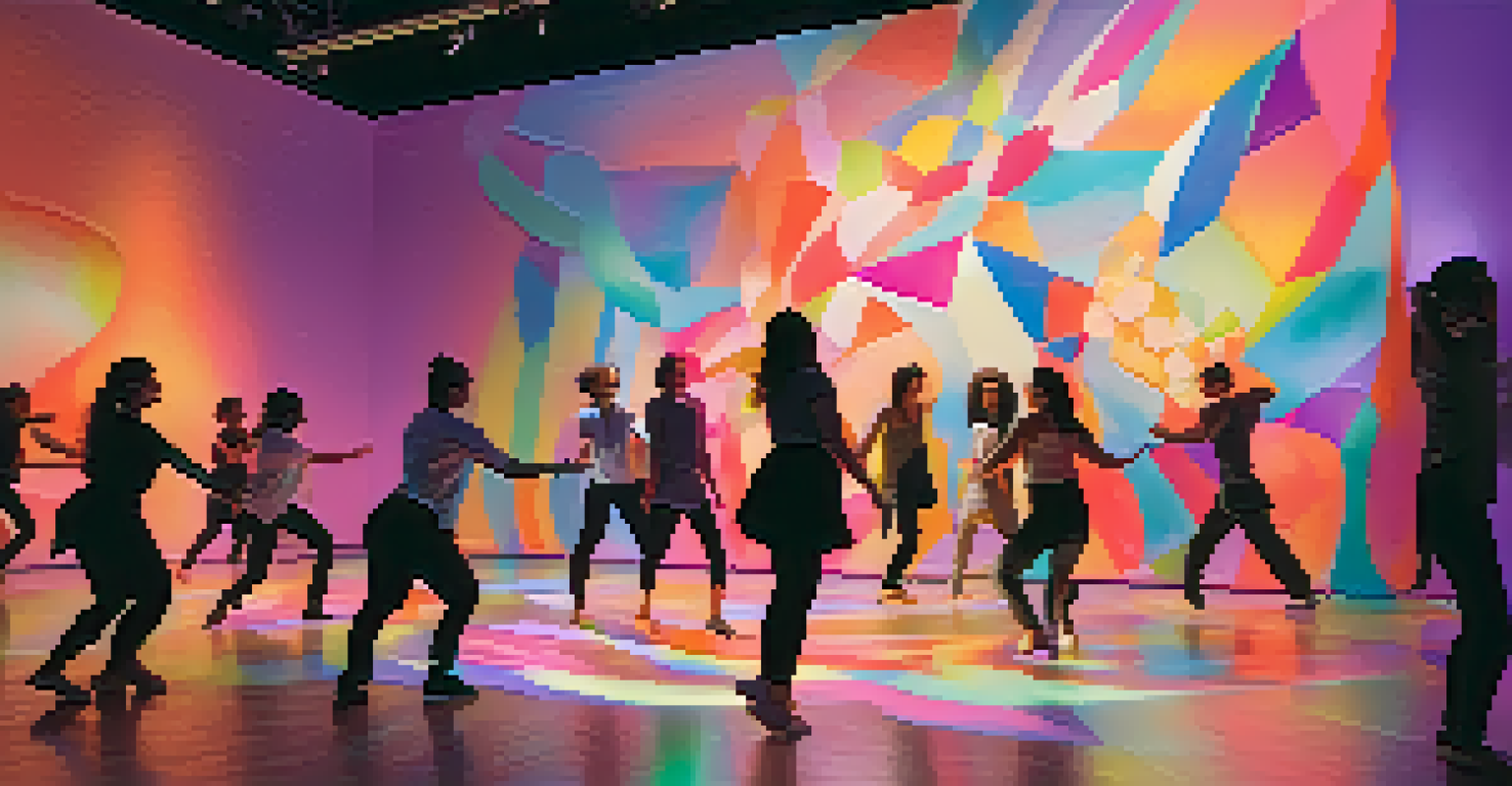The Evolution of Dance in Contemporary Visual Art Installations

Tracing the Roots: Dance and Visual Art Intertwined
Dance and visual art have shared a rich history, dating back to ancient rituals where movement was a form of storytelling. From cave paintings depicting dancers to the intricate designs of temple sculptures, these forms have long influenced each other. This connection laid the groundwork for contemporary artists who seek to blend these two expressive mediums, creating immersive experiences that resonate with audiences on multiple levels.
Dance is the hidden language of the soul.
In the 20th century, movements such as Dada and Surrealism further blurred the lines between dance and visual art. Artists like Martha Graham and Merce Cunningham began collaborating with visual artists, merging choreography with innovative set designs. This sparked a wave of experimentation that has only grown in the contemporary art scene, leading to the integration of performance art into galleries and public spaces.
Today, this historical relationship continues to evolve, with contemporary installations increasingly incorporating dance as a central element. This evolution reflects a broader cultural trend of embracing diverse forms of expression, inviting viewers to engage not just as spectators but as participants in the artistic experience.
The Rise of Performance Art: A New Dimension
Performance art emerged as a distinct genre in the mid-20th century, challenging traditional boundaries of art. Artists like Marina Abramović and Yoko Ono used their bodies as canvases, often incorporating movement and dance to convey powerful messages. This shift not only redefined how audiences interact with art but also opened the door for dance to take center stage in visual art installations.

In contemporary settings, performance art often invites spontaneity and improvisation, encouraging a dialogue between the artist and the audience. This dynamic creates an environment where dance can express emotions and narratives that static art forms may struggle to convey. By breaking away from the confines of the stage, performance artists have made dance an integral part of the visual art experience.
Dance and Art's Historical Bond
Dance and visual art have intertwined for centuries, influencing each other through various cultural expressions and contemporary collaborations.
Moreover, the rise of social media has amplified the visibility of performance art, allowing artists to reach wider audiences. Videos of dance installations can go viral, attracting attention to the art form and inspiring new collaborations across disciplines. This interconnectedness highlights the ongoing evolution of dance within contemporary visual art.
Technology's Role in Transforming Dance Installations
The advent of technology has had a profound impact on how dance is integrated into visual art installations. Video projections, interactive installations, and virtual reality experiences have transformed traditional perceptions of dance. These technological advancements allow artists to create immersive environments where dance can unfold in unique and unexpected ways.
Art is not a thing; it is a way.
For instance, choreographers can now collaborate with digital artists to produce multimedia experiences that blend live performance with visual effects. This fusion not only enhances the aesthetic appeal but also challenges audiences to rethink their relationship with both dance and visual art. Imagine walking through a gallery where dancers move in harmony with projected images, creating a dialogue that transcends the limitations of each medium.
Additionally, technology has democratized access to dance, enabling artists from diverse backgrounds to showcase their work to global audiences. Online platforms and social media have made it easier for choreographers to share their performances, fostering a sense of community among artists and art lovers alike. This evolution signifies a new era where dance and technology coexist, pushing the boundaries of contemporary visual art.
Cultural Influences: Dance as a Reflection of Society
Dance in contemporary visual art installations often serves as a mirror reflecting societal issues and cultural narratives. Artists draw inspiration from their backgrounds, using movement to address themes such as identity, race, and social justice. This allows viewers to engage with complex topics through the lens of art, fostering dialogue and understanding.
For example, choreographers like Bill T. Jones have used dance to explore the intersection of race and sexuality, creating powerful installations that provoke thought and challenge societal norms. These works not only highlight the beauty of movement but also emphasize the importance of context and narrative in dance. As a result, they resonate deeply with audiences, making art a catalyst for change.
Performance Art's Evolving Role
The rise of performance art has redefined audience interaction, making dance a vital component of visual art installations.
Moreover, contemporary dance often incorporates traditional and folk styles, celebrating cultural heritage while pushing the envelope of modern expression. This blending of styles creates a rich tapestry of movement that enriches the visual art landscape. It reminds us that dance is not just an art form but a vital expression of our collective human experience.
Collaboration: Bridging Dance and Visual Arts
Collaboration between dancers and visual artists has become a hallmark of contemporary installations, resulting in innovative and engaging experiences. This partnership allows for the fusion of movement and visual storytelling, creating a multi-dimensional art form that captivates audiences. By working together, artists can explore new concepts and push creative boundaries.
Notable collaborations, such as those between choreographer Crystal Pite and visual artist Jonathon Young, demonstrate the power of merging these two disciplines. Their work showcases how dance can enhance visual narratives, transforming a gallery into a living, breathing installation. This symbiotic relationship enriches the artistic landscape, inviting viewers to experience art in a holistic way.
Additionally, these collaborations often encourage artists to step outside their comfort zones, leading to unexpected outcomes and fresh perspectives. For emerging artists, this environment fosters creativity and exploration, paving the way for new voices in the art world. Ultimately, collaboration not only enhances the artistic process but also broadens the appeal of dance within contemporary visual art.
Audience Engagement: The Role of Interaction in Art
Contemporary visual art installations often seek to engage audiences on a deeper level, transforming them from passive observers into active participants. Dance plays a crucial role in this engagement, inviting viewers to interact with the performance and the space in which it occurs. This shift creates a more immersive experience, fostering a connection between the audience and the artwork.
For instance, installations that encourage audience movement or participation allow people to become part of the art itself. This blurs the line between artist and viewer, making the experience more personal and impactful. By incorporating dance, artists can evoke emotions and reactions that resonate with individuals, transforming the way art is perceived.
Technology Shapes Dance Experiences
Advancements in technology are transforming how dance is experienced in visual art, creating immersive environments that challenge traditional perceptions.
The rise of participatory art has led to a growing appreciation for the role of community in the creative process. Events like flash mobs or interactive dance performances encourage collective experiences that celebrate movement and expression. This evolution highlights the importance of connection and collaboration, both within the art world and among its audiences.
Future Trends: The Next Chapter in Dance and Art
As we look ahead, the relationship between dance and contemporary visual art is poised to evolve even further. Emerging trends suggest a continued integration of technology, with virtual and augmented reality reshaping how audiences experience performances. This shift could lead to entirely new forms of immersive art, where viewers can explore dynamic environments that blend movement and visual storytelling.
Moreover, the growing emphasis on inclusivity and diversity in the arts will likely influence the future of dance in visual installations. Artists are increasingly drawing from a wide range of cultural backgrounds and perspectives, enriching the artistic landscape with varied narratives. This commitment to representing diverse voices promises to create a more vibrant and multifaceted art world.

Finally, as contemporary art continues to challenge norms and expectations, we may see dance taking on even more experimental forms. Artists are likely to push boundaries, exploring new ways to incorporate movement into visual art, sparking conversations that resonate across generations. The future of dance in contemporary visual art installations is bright, inviting us all to partake in this dynamic journey of creativity and expression.